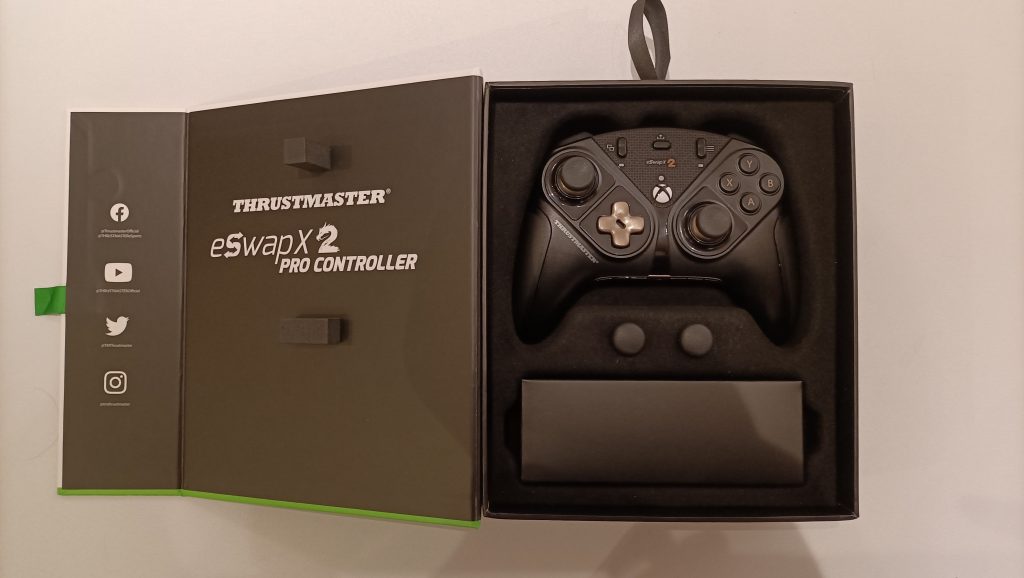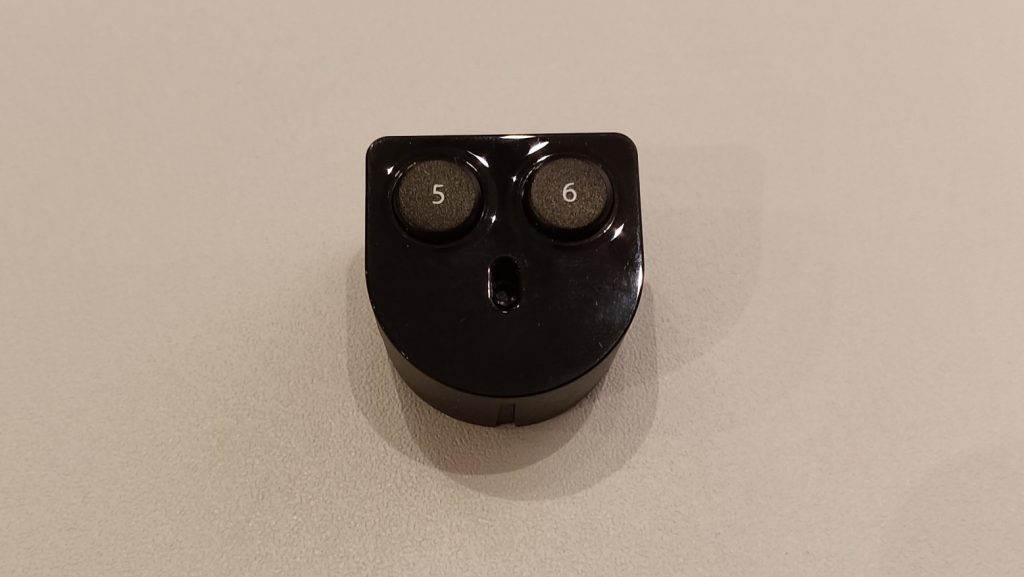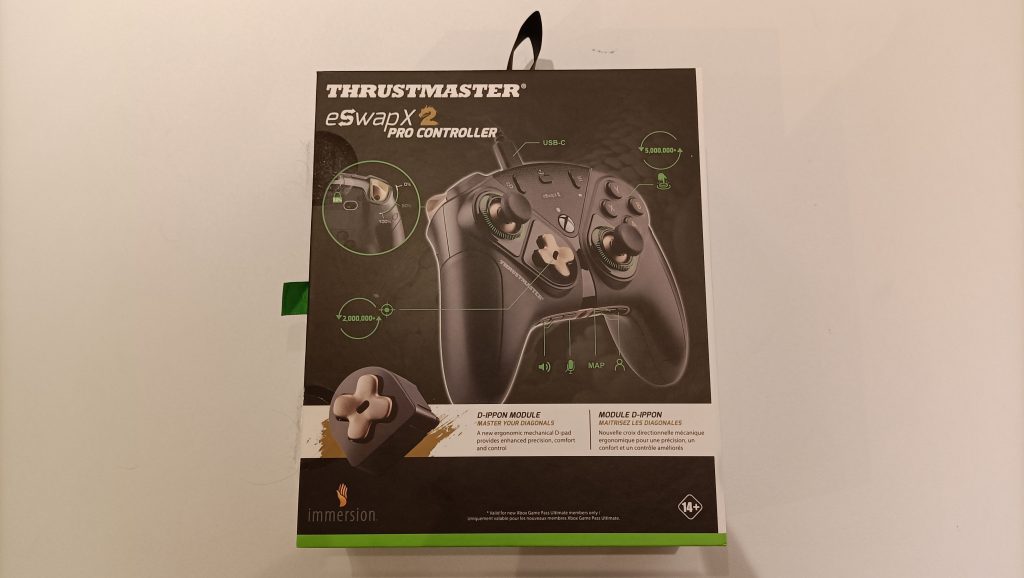Thrustmaster ESWAP X2 Pro Controller Review
Summary: A high-end pro controller with some very interesting options for customisation and accessibility. The lack of wireless connectivity may be a deal breaker for some though.
4.5
Customisable!
When it comes to pro controllers there are quite a few options these days, and not just first-party offerings from Sony, Microsoft, and Nintendo. Recently I’ve been using the latest of Thrustmaster’s high-performance line, the ESWAP X2 pro controller for Xbox One, Xbox Series consoles, and PC.
After unboxing the controller and taking a look at what came with it, my initial thoughts were that this is a very nice, high-end product. There’s a feeling of quality to it, the controller has a fairly substantial amount of weight similar to that of a Series X controller and it doesn’t feel flimsy like some third-party controllers occasionally do.
The box contains the controller itself, an additional pair of domed, rubber stick-caps similar to that of the older Dual Shock controllers, a 3-meter braided type C to A cable, a soft storage bag, and a small screwdriver that also doubles as a tool to remove the D-pad module.
This, of course, is one of the main selling points of the ESWAP X2 pro controller. Both analog sticks and the D-pad come as interchangeable modules that can be swapped out at will. So, whether you prefer the Xbox’s asymmetrical stick layout or that used by PlayStation on their controllers, you’re covered. The modules are held in place by fairly strong magnets, there’s a satisfying amount of pull and a nice click into place when changing them around and they’re strong enough to not feel like they’re ever in danger of coming loose while in use.
The analog sticks themselves are Thrustmaster’s own S5 NXG mini sticks. Which claim to have ‘33% better resistance, 66% better-re-centering precision and double the lifespan for the button in them’. I scoured the internet looking for some kind of explanation of how this is achieved but so far have come up with nothing. They’re not hall effect sticks, so are prone to the same stick drift as most other controllers on the market, I’m even confused about the whole ‘mini’ aspect of the branding because they felt taller than almost any other analog stick I’ve ever used.
That said, they really do feel nice to use. The 33% ‘better’ resistance is debatable (how do you quantify ‘better’?), they honestly didn’t feel much different from any other controller I’ve got from the last few generations in terms of resistance, but they’re definitely very smooth and precise. I thought I was going to have an issue with the stick height too, but it didn’t turn out to be a problem at all.
The D-pad is… alright? It’s passable. It’s got a satisfying click when used, I did find that the D-pad itself moved around a lot though, not the module, which didn’t budge, but the top surface has a bit of wiggle room to it that I found annoying when using. The closest comparison I can make is when the D-pad of old Megadrive/Genesis controllers started to get worn and they rocked around a little more.
All of the face buttons use mechanical switches rather than a traditional membrane for activation. This allows for an incredibly low action on each button, Thrustmaster claims that it’s 0.01”/0.3mm, and I believe them. They have a feel akin to that of a PC mouse click, with a very similar sound come to think of it. It took a bit of getting used to, having such low action and high responsiveness compared to a traditional controller. In casual gameplay, I can’t see it making a huge amount of difference for most people, but for the competitive crowd, it could very well be a game-changer.
Each of the triggers atop the controller has a relatively short travel distance and has a good weight to them. There’s a little resistance when used and can be further customised via two switches on the back of the controller, with one setting being the default and the other halving the travel range of the trigger, making it a much faster activation. It’s perfect for something like Call of Duty or Fortnite when getting shots off quicker than your opponent can mean winning or losing a fight. The triggers are also customisable, with only one small screw holding them in place. Thrustmaster currently has various options for colours available to buy separately on their website.
These customisation options extend to the thumbsticks, D-pad, and grips on the side of the controller, which are also magnetic and can be easily popped off and swapped out.
Perhaps the best thing about the ESWAP X2 pro controller is the fact that modules can be easily swapped out. Given stick drift is a very real possibility for heavy users, being able to buy a replacement that just drops in and is ready to use in seconds is a very attractive proposition. Replacement sticks and D-pad modules are available at a very affordable price and should ensure a long life for the controller.
Even more interestingly, there’s a series of more niche modules that can be dropped in and used. The first of these is part of the ‘Fighting Pack’ and is a replacement for the right stick. This module adds two more face buttons, turning it into a classic 6-button controller, perfect for Street Fighter and Tekken, etc. I’m not much of a fighting game player, at least not a good one anyway, but found it bridged the gap between a controller and a fight stick quite nicely.
The second of these is the Forza Horizon 5 branded racing wheel, which can best be described as a miniature steering wheel, complete with re-centering. Unfortunately, I didn’t get to test the wheel add-on, only the fighting game module, but it’s something I’m definitely curious about.
Four buttons can be found on the rear side of the controller, these are completely remappable to two different presets. By default, one preset is the face buttons and the other is the shoulder buttons but can be set up in any way the player desires. All of this can be set up and tweaked in ThrustmapperX, Thrustmaster’s own software for updating the controller firmware and customisation.
Deadzones for the sticks and triggers can also be tweaked and set to the two profiles, making for a surprisingly in-depth and customisable experience. The software is available both on PC (though only through the Microsoft Store for some reason) and on Xbox, meaning that a PC isn’t required for console players to update firmware or tweak things.
Perhaps best of all, is that a lot of the tweaking can be done on the fly in a game, without needing to dive into the software thanks to a button for remapping controls.
The ThrustmapperX software itself isn’t overly complicated. All of the controller’s face buttons can be remapped, which is fantastic as an accessibility option for those who need it. The only real issue I had with it, is that it’s limited to only two profiles for customisation for some reason, and while not a deal breaker, it would have been nice to create more, even if it required using the software to change them. The software itself is a bit of a resource hog for some reason too. For whatever reason whenever it was open and the active window, it would use around 25% of my CPU, which is odd for something otherwise so basic.
So, everything sounds pretty good so far, what are the downsides to the ESWAP X2 pro controller, if any?
The biggest negative for me, and the thing that’s potentially stopping it from being my go-to controller of choice for both Xbox and PC, is the fact that it’s exclusively a wired controller. I get that this is primarily aimed at the eSports and competitive gaming crowd, and the tiny amount of latency from a wireless controller could make a difference, but at the price point it’s at, it’s a bit of a deal breaker.
At £169.99/€179.99/$169.99, it’s a bit of a hard sell unless you desperately want the interchangeable modules. For comparison, the Xbox Elite Controller 2 is cheaper, wireless, comes with a hardcase, and while it doesn’t have fully interchangeable modules, it has more or less the same feature set.
Final Thoughts?
Thrustmaster has left me a little conflicted with the ESWAP X2 pro controller. On the one hand, it’s a very competently made, feature-rich controller that feels good to use and has a lot of options for customisation and self-repair should they be necessary. On the other hand, it’s permanently tethered to whatever you’re using via a cable, the price is quite steep when you consider you’re not getting hall effect sticks, wireless functionality, or even a hardcase.
I’m still torn on whether I’m going to be daily driving it for Xbox and PC, though I will say this, as someone who had another Dual Sense controller end up on scrapheap literally hours before writing this review due to stick drift, the module system Thrustmaster has developed is a big selling point to me right now. If they made one for PlayStation 5, I’d be on it in a heartbeat.
If you’re fine with the lack of wireless play in a controller, then definitely give the ESWAP X2 a look if you’re looking for a higher-end device. There’s a lot to like here, just with some caveats.
















